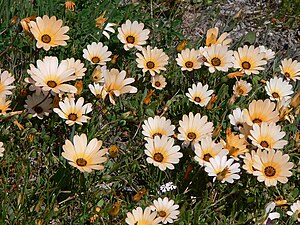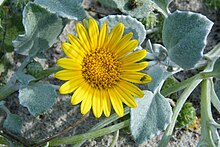Arctotideae
| Arctotideae | ||||||||||||
|---|---|---|---|---|---|---|---|---|---|---|---|---|

|
||||||||||||
| Systematics | ||||||||||||
|
||||||||||||
| Scientific name | ||||||||||||
| Arctotideae | ||||||||||||
| Cass. |
Arctotideae is a tribe in the Asteraceae plant family. Best known are the gazania - hybrids , which in sunny spots in parks and gardens as ornamental plants are used; Arctotis hybrids are used somewhat less often for the same purpose.
description


Vegetative characteristics
The species of the Tribus Arctotideae are herbaceous plants : annual or perennial; or rarely woody plants: Half bushes or shrubs . Some species are prickly. Some species, especially Gazania, have a white milky sap .
The leaves, which are mostly alternate and arranged in basal rosettes or distributed on the stem, are stalked or sessile. The leaf blades rarely have a smooth, usually a more or less serrated to prickly serrated or lobed leaf margin; in some species it is divided.
Generative characteristics
Usually the cup-shaped inflorescences stand individually on more or less long stems or rarely in cluster- like to cluster-like total inflorescences together, sometimes in partial inflorescences of the 2nd order. The mostly unequal bracts are rarely two, usually three to over six rows, they can be free to more or less overgrown and are usually herbaceous, less often fleshy, sometimes they are prickly (see picture by Berkheya spinosissima ). The flower head bases are flat to conical. Chaff leaves are seldom present. In each flower head there are outer, zygomorphic ray- flowers (= ray-flowers) and inner, radially symmetrical tubular flowers (= disc-shaped flowers). At the edge there are one or two rows, mostly female, they can be fertile or sterile, sometimes asexual ray flowers are present; their tongue ends in rarely two, mostly three or four crown teeth and the colors of their petals range from white, yellow to orange to red and purple to blue. The disc florets are mostly hermaphroditic and fertile, sometimes functionally male; their corolla tube ends in four or five corolla teeth and the colors of their petals range from yellow to dark brown to purple
The mostly ribbed fruits of the achenes type usually have a permanent wreath of hair or pappus , which consists of more or less two rows with usually four to eight, rarely more than 16 scales or is sometimes crown-shaped.
Systematics and distribution






The main distribution area is the whole of southern Africa, with the majority of the species being elements of the Cape flora (Capensis). Therefore the English name "African Daisies" is also justified. The center of biodiversity is in winter rain areas . The two Cymbonotus species are only found in Australia. Some species became invasive plants , especially in frost-free areas of the world .
The Tribus Arctotideae was first published in 1816 by Alexandre Henri Gabriel de Cassini in Journal of natural philosophy, chemistry and the arts , 88, 159. Orthographic variant: Arctoteae Cass.
The tribe Arctotideae is divided into two or three subtribes with about 13 to 17 genera and about 200 to 220 species:
- Subtribus Arctotidinae: It contains about five genera with about 81 species:
-
Arctotheca J.C. Wendl. : The roughly four species are common to Mozambique and South Africa, for example
- Cape dandelion ( Arctotheca calendula (L.) Levyns )
-
Bear Ears ( Arctotis L. ): The 64 species are distributed from Capensis to Angola . Including:
- Magnificent bear's ear ( Arctotis fastuosa Jacq. )
- Cymbonotus Cass. : The only two types are common in Australia .
-
Dymondia Compton : it contains only one species:
- Dymondia margaretae Compton : This endemic thrives in the South African province of Western Cape at altitudes of 160 to 200 meters only in the Southern Overberg region from Cape Agulhas to Potberg .
- Haplocarpha Less. : The tenor sospecies are found in Africa, three of them from the Afro-montane eastern Africa to Eritrea , five species only occur in the Capensis.
-
Arctotheca J.C. Wendl. : The roughly four species are common to Mozambique and South Africa, for example
- Subtribe Gorteriinae Benth. & Hook.f. : It contains eight genera with about 130 species:
- Berkheya Ehrh. : The 75 or so species are mainly found in the Capensis, only four species occur in other areas of Africa.
- Cullumia R.Br. : The approximately 15 species occur in the South African provinces of the North Cape and the Western Cape .
-
Cuspidia Gaertn. : It contains only one type:
- Cuspidia cernua ( L. f. ) BLBurtt : It is common in the South African provinces of the North Cape, Western Cape and Eastern Cape .
- Didelta L'Hér. : The only two species are common in the western part of the Capensis.
- Gazania Gaertn. : The approximately 17 species are mainly distributed in the Capensis, but two species extend further north.
- Gorteria L .: The three or so species are common in the Capensis.
-
Heterorhachis Sch.Bip. ex Walp. : It contains only one type:
- Heterorhachis aculeata ( Burm. F. ) Roessler : It occurs in the South African provinces of the North Cape and the Western Cape.
- Hirpicium Cass. : The twelve or so species are distributed in tropical and southern Africa, eight of which are found only in the Capensis.
- Subtribe Eremothamninae: It contains only two genera with only three species (according to Worthley, Funk & Skarla, it may not belong in this tribe):
-
Pteronia L .: This subheading includes:
- Pteronia marlothiana (O.Hoffm.) Dinter (Syn .: Eremothamnus marlothianus O.Hoffm. ): It occurs only in Namibia.
- Hoplophyllum DC. : The only two species occur in the South African provinces of the Northern and Western Cape.
-
Pteronia L .: This subheading includes:
- Unsafe position:
- Heterolepis Cass. : The only three species occur only in the South African province of Western Cape .
- Platycarpha Less. : The only three types are common in southern Africa.
swell
- Theodore M. Barkley, Luc Brouillet, John L. Strother: Asteraceae : Tribus Arctotideae , p. 195 - online with the same text as the printed work , Flora of North America Editorial Committee (ed.): Flora of North America North of Mexico. Volume 19: Magnoliophyta: Asteridae, part 6: Asteraceae, part 1 (Mutisieae – Anthemideae) , Oxford University Press, New York and Oxford, 2006, ISBN 0-19-530563-9 . (Sections Description and Systematics)
- PO Karis: Tribe Arctotideae , pp. 200–207, In: JW Kadereit & C. Jeffrey: Families and Genera of Vascular Plants, Volume VIII, Flowering Plants, Eudicots, Asterales , Springer-Verlag, Berlin, 2007.
- Alexandra H. Wortley, Vicki A. Funk, John J. Skvarla: Pollen and the evolution of Arctotideae (Compositae). In: The Botanical Review , 2008: Online.
- Vicki A. Funk, Raymund Chan: Phylogeny of the Spiny African Daisies (Compositae, tribe Arctotideae, subtribe Gorteriinae) based on tmL-F, ndhF, and ITS sequence data. In: Molecular Phylogenetics and Evolution , Volume 48, 2008, pp. 47-60.
- Vicki A. Funk, Raymund Chan, Sterling C. Keeley: Insights into the evolution of the subfamily Cichorioideae sensu stricto and tribe Arctoteae (Compositae) using trnL, ndhF, and ITS sequence data. In: Taxon , Volume 53, Issue 3, 2004, pp. 637-655: Online.
- Robert J. McKenzie, Elizabeth M. Muller, Amy KW Skinner, Per Ola Karis, Nigel P. Barker: Phylogenetic relationships and generic delimitation in subtribe Arctotidinae (Asteraceae: Arctotideae) inferred by DNA sequence data from ITS and five chloroplast regions. In: American Journal of Botany , 93, 2006, pp. 1222-1235: Online.
Individual evidence
- ↑ Arctotideae in the Flora of North America , Volume 19, p. 195 - the same text online as the printed work , In: Flora of North America Editorial Committee (Ed.): Flora of North America North of Mexico. Volume 19: Magnoliophyta: Asteridae, part 6: Asteraceae, part 1 (Mutisieae – Anthemideae). Oxford University Press, New York and Oxford, 2006, ISBN 0-19-530563-9 .
- ↑ Alexandra H. Wortley, VA Funk, John J. Skvarla: Pollen and the evolution of Arctotideae (Compositae). In: The Botanical Review , 2008: Online. ( Memento of the original from September 24, 2015 in the Internet Archive ) Info: The archive link was inserted automatically and has not yet been checked. Please check the original and archive link according to the instructions and then remove this notice.
- ↑ a b c d e f g h i j Arctotideae in South Africa. at Biodiversity Explorer from Iziko = Museums of Cape Town. (engl.)
- ↑ Vicki A. Funk, Raymund Chan, A. Holland: Cymbonotus (Compositae: Arctotideae, Arctotidinae): An endemic Australian genus embedded in a southern African clade. In: Botanical Journal of the Linnean Society , Volume 153, Isse 1, 2007, pp. 1-8.
- ↑ Monique McQuillan, 2009: Dymondia margaretae Compton at PlantZAfrica .
further reading
Robert J. McKenzie, Nigel P. Barker: Radiation of southern African daisies: Biogeographic inferences for subtribe Arctotidinae (Asteraceae, Arctotideae). In: Molecular Phylogenetics and Evolution , Volume 49, Issue 1, 2008, pp. 1-16.
